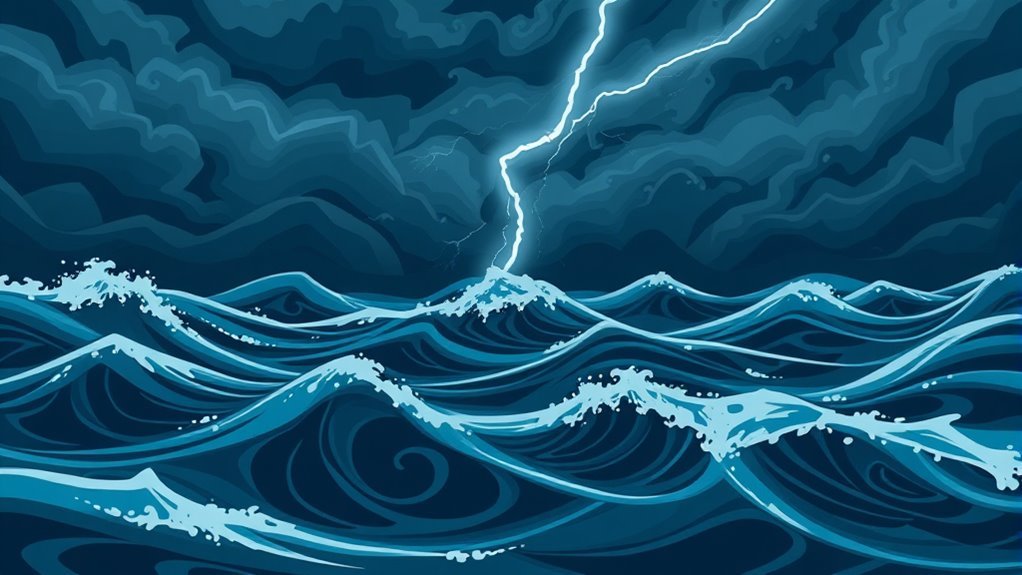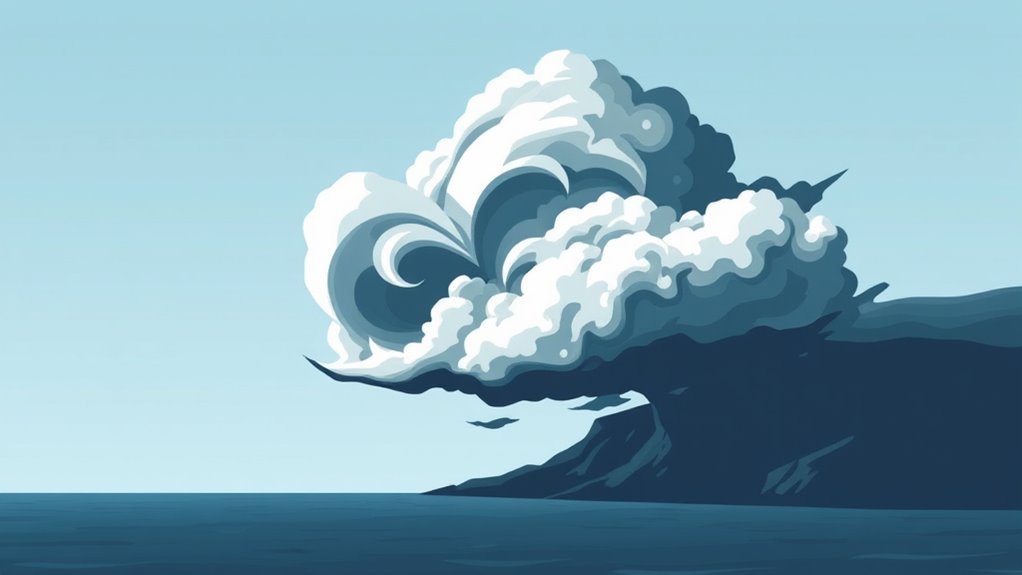El Niño and La Niña greatly affect global squall activity by altering ocean temperatures and atmospheric conditions. El Niño creates warmer sea surface temperatures, leading to increased squall intensity, particularly in the Eastern Pacific. In contrast, La Niña's cooler temperatures improve squall activity in the Western Pacific while diminishing it in the Eastern region. Both phenomena also influence tropical storm formation patterns and regional weather variability. Further exploration reveals more complex details about these climate oscillations and their global impacts.
Main Points
- El Niño increases squall intensity and frequency in the Eastern Pacific due to warmer sea surface temperatures enhancing evaporation and moisture.
- La Niña leads to more intense squalls in the Western Pacific but may reduce activity in the Eastern Pacific due to altered wind patterns.
- The Caribbean typically experiences stronger squalls during El Niño, while La Niña promotes increased Atlantic hurricane activity and decreased Pacific storms.
- Historical La Niña events are associated with powerful cyclones, heavier rainfall, and prolonged hurricane seasons, affecting storm tracks and landfall locations.
- Understanding El Niño and La Niña is crucial for predicting squall activity and preparing communities for potential extreme weather events influenced by climate change.
Understanding El Niño and La Niña: Definitions and Mechanisms
El Niño and La Niña are remarkable climatic phenomena that arise from variations in oceanic and atmospheric conditions in the central and eastern Pacific Ocean.
El Niño occurs when warmer sea surface temperatures develop in the equatorial Pacific, leading to notable alterations in global weather patterns. This warming can disrupt normal wind patterns and precipitation, impacting regions far beyond the Pacific.
Conversely, La Niña is distinguished by cooler sea surface temperatures in the same region, which usually improves prevailing trade winds and can lead to increased rainfall in some areas while causing droughts in others.
Both phenomena are part of a larger oscillation known as the El Niño-Southern Oscillation (ENSO).
The mechanisms driving these events are complex, involving interactions between the ocean and atmosphere, which ultimately affect weather systems worldwide.
Understanding these dynamics is essential for predicting their effects on global squall activity and related weather phenomena.
The Role of Ocean Temperatures in Weather Patterns

Ocean temperatures considerably influence weather patterns, as variations can lead to dramatic shifts in atmospheric behavior. Warmer ocean waters often improve evaporation rates, increasing moisture in the atmosphere and subsequently intensifying storm systems. This phenomenon can alter wind patterns, contributing to the formation of squalls and other severe weather events.
Conversely, cooler ocean temperatures can suppress evaporation, leading to reduced humidity and disrupted weather systems.
The interactions between ocean temperatures and atmospheric conditions are particularly evident during El Niño and La Niña events. During El Niño, warmer surface waters in the Pacific Ocean can trigger stronger and more frequent storms, while La Niña, defined by cooler waters, often results in drier conditions in certain regions.
These temperature-driven changes underscore the critical role of the oceans in shaping global weather patterns and highlight the interconnectedness of marine and atmospheric dynamics. Understanding these relationships is essential for predicting squall activity and other weather phenomena.
Historical Impact of El Niño on Squall Activity
The historical impact of El Niño on squall activity reveals noteworthy trends in frequency and intensity.
Observations indicate that variations in regional climate can lead to differing responses in squall events during El Niño episodes.
Understanding these patterns is essential for predicting future weather phenomena associated with this climate phenomenon.
El Niño Frequency Trends
Although various climatic phenomena influence weather patterns, El Niño events have exhibited a notable frequency and intensity that greatly impact squall activity.
Historical data indicates that the occurrence of El Niño has increased, particularly in the late 20th and early 21st centuries. This rise in frequency aligns with global climatic changes, suggesting a potential correlation between human-induced climate shifts and the prevalence of El Niño events.
Researchers have noted that these events typically manifest every two to seven years, but patterns show variability, with some decades experiencing multiple occurrences.
The increased frequency of El Niño events raises concerns about their consequences for squall activity, particularly in regions most susceptible to severe weather phenomena, warranting further investigation into these trends and their broader climatic outcomes.
Intensity of Squall Events
When examining the historical impact of El Niño on squall activity, it becomes evident that variations in intensity are closely linked to these climatic events.
During El Niño years, squall events often exhibit increased intensity, leading to more severe weather patterns, including heightened winds and heavier precipitation. This intensified squall activity can result in considerable damage to infrastructure and ecosystems.
Conversely, during non-El Niño periods, squalls tend to be less intense, showcasing a clear correlation between the presence of El Niño and heightened squall severity.
Studies have documented these patterns, indicating that regions affected by El Niño experience a marked increase in squall event intensity, further underscoring the influence of this climatic phenomenon on global weather dynamics.
Regional Variability Observations
Regional variability in squall activity during El Niño events reveals remarkable differences across various geographical areas.
In the eastern Pacific, increased sea surface temperatures often lead to heightened squall frequency, particularly in coastal regions of Central America.
Conversely, the western Pacific experiences a reduction in squall activity due to altered atmospheric circulation patterns.
Observations indicate that the Indian Ocean also shows considerable variability; during El Niño, regions like the Bay of Bengal may witness intensified squall formations, while the Arabian Sea often sees diminished activity.
Additionally, the Caribbean region typically faces stronger squalls, enhancing storm potential.
Historical Impact of La Niña on Squall Activity

La Niña events have historically played a remarkable role in shaping squall activity across various regions. These phenomena, defined by cooler ocean temperatures in the central and eastern Pacific, tend to boost atmospheric circulation patterns, leading to increased squall formation, particularly in tropical and subtropical areas.
Research indicates that during La Niña years, regions such as the western Pacific often experience more frequent and intense squalls. This is attributed to improved convection and moisture availability, which contribute to the development of severe weather systems.
Conversely, areas like the eastern Pacific may see a reduction in squall activity, as the shifts in wind patterns can inhibit storm formation.
Historical data shows that noteworthy La Niña events correlate with remarkable increases in squall-related impacts, including heavy rainfall and strong winds, thereby affecting local ecosystems and human activities.
Understanding these historical patterns is essential for predicting future squall responses to La Niña events.
The Interplay Between El Niño, La Niña, and Tropical Storms

El Niño and La Niña greatly influence tropical storm activity, each exhibiting distinct effects on cyclone formation and intensity.
During El Niño events, conditions tend to suppress storm development in certain regions, while La Niña often boosts cyclone activity.
Understanding the seasonal variability between these phenomena is vital for predicting storm patterns and mitigating potential impacts.
El Niño's Impact on Storms
While various climatic phenomena influence storm activity, El Niño stands out for its notable impact on tropical storms. During El Niño events, the warming of ocean waters in the central and eastern Pacific alters atmospheric circulation patterns.
This change often leads to a decrease in the frequency and intensity of tropical storms in the Atlantic basin, as increased vertical wind shear inhibits storm development. Conversely, in the eastern and central Pacific, El Niño can contribute to more active storm seasons.
These variations arise from the complex interplay of oceanic and atmospheric dynamics, underscoring El Niño's role in shaping global storm patterns. Understanding these effects is essential for improving forecasting and preparedness for tropical storm events.
La Niña's Influence on Cyclones
Although El Niño significantly influences storm patterns, La Niña presents a contrasting effect on cyclone activity. During La Niña events, the reduction in wind shear and improved ocean temperatures typically lead to increased cyclone formation. This phenomenon can intensify storms, particularly in the Atlantic and Pacific regions.
- La Niña correlates with a higher frequency of hurricanes.
- Cyclones tend to be more powerful during La Niña phases.
- The phenomenon can prolong the hurricane season.
- La Niña influences storm tracks, affecting landfall locations.
Understanding La Niña's influence is vital for meteorologists and climate scientists, as it helps predict potential cyclone activity and prepares communities for the possible impacts of these intensified storms.
Seasonal Variability in Activity
The interplay between El Niño and La Niña greatly shapes seasonal variability in tropical storm activity. During El Niño events, warmer ocean temperatures can lead to suppressed storm formation in the Atlantic, while enhancing activity in the Pacific.
Conversely, La Niña typically encourages cooler waters, resulting in increased Atlantic hurricane activity and reduced Pacific storm formation. These oscillations create contrasting conditions that affect timing, intensity, and frequency of tropical storms.
Seasonal patterns further complicate this relationship, as variations in atmospheric circulation, wind shear, and moisture levels fluctuate between El Niño and La Niña phases.
Consequently, understanding these dynamics is essential for accurate forecasting, as they directly influence the potential impact of tropical storms on coastal regions and global weather patterns.
Regional Variations in Squall Activity Due to Climate Oscillations
As climate oscillations such as El Niño and La Niña influence global weather patterns, their effects on squall activity exhibit substantial regional variations.
Different regions experience unique changes in squall frequency and intensity due to these oscillations, leading to distinct climatic impacts.
- Coastal areas may see increased squall activity during El Niño, enhancing rainfall.
- La Niña typically results in drier conditions in the southeastern United States, reducing squall events.
- Tropical regions often face stronger and more frequent squalls during El Niño phases, impacting local ecosystems.
- Conversely, La Niña can lead to increased squall activity in parts of the western Pacific, contributing to heightened storm risks.
These variations underscore the complexity of climate interactions and highlight the importance of regional assessments in understanding the broader consequences of climate oscillations on squall dynamics.
Future Predictions: El Niño, La Niña, and Squall Activity Trends
While uncertainty remains regarding the precise impacts of climate change on future El Niño and La Niña events, projections indicate that these oscillations will continue to greatly influence squall activity. Research suggests that the frequency and intensity of these phenomena may change, potentially leading to more extreme weather patterns.
El Niño conditions are often associated with increased squall activity in certain regions, while La Niña events can produce contrasting effects.
As global temperatures rise, the dynamics of these oscillations could shift, altering their historical patterns. Some models predict that improved warming may intensify El Niño events, which could result in an uptick in squalls in affected areas.
Conversely, La Niña might persist longer, leading to prolonged dry spells interspersed with sudden squall events.
Common Questions
How Do El Niño and La Niña Affect Global Rainfall Patterns?
El Niño and La Niña considerably influence global rainfall patterns by altering atmospheric circulation. El Niño typically leads to increased precipitation in some regions, while La Niña often causes drier conditions elsewhere, affecting agricultural and water resources.
Can El Niño and La Niña Influence Hurricane Seasons?
The influence of El Niño and La Niña on hurricane seasons is substantial. El Niño typically suppresses hurricane activity, while La Niña tends to boost it, altering patterns of frequency and intensity in tropical cyclones.
What Are the Economic Impacts of Squall Activity During These Events?
The economic impacts of squall activity can be substantial, affecting agriculture, infrastructure, and local economies. Increased rainfall and strong winds can lead to crop damage, property destruction, and heightened emergency response costs, straining financial resources.
How Do Local Communities Adapt to Changes in Squall Activity?
Local communities adjust to changes in squall activity by implementing early warning systems, enhancing infrastructure resilience, diversifying livelihoods, and engaging in community education programs. These strategies help mitigate risks and encourage sustainable practices in vulnerable regions.
Are There Any Health Implications Related to Squall Activity During These Phenomena?
Health consequences related to squall activity can include increased respiratory issues from dust and allergens, heightened risk of injuries during storms, and potential outbreaks of waterborne diseases due to flooding and disrupted sanitation systems.

